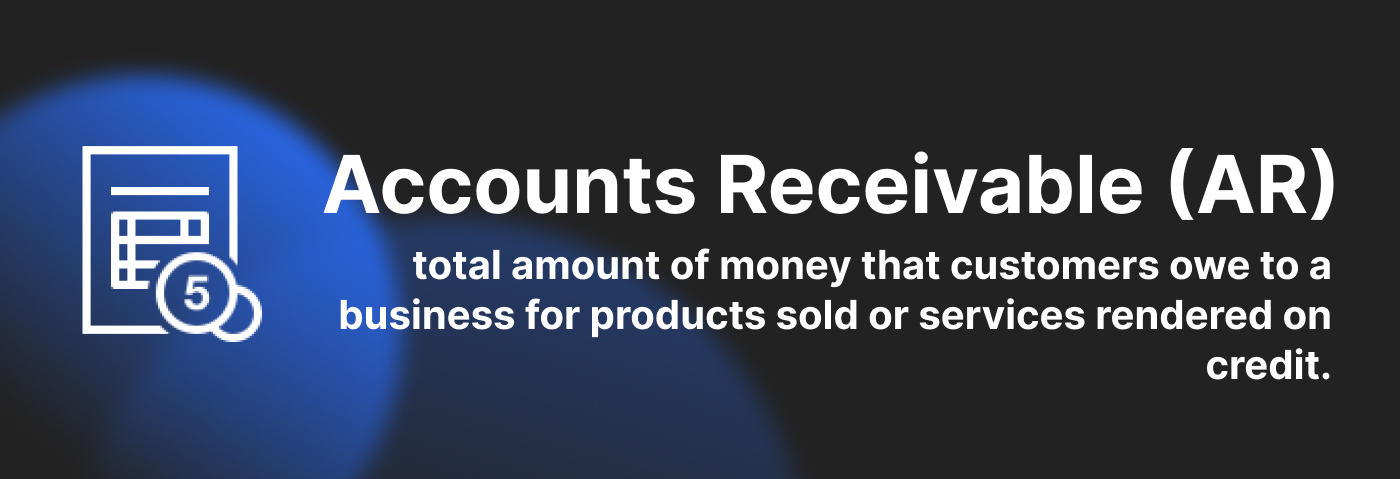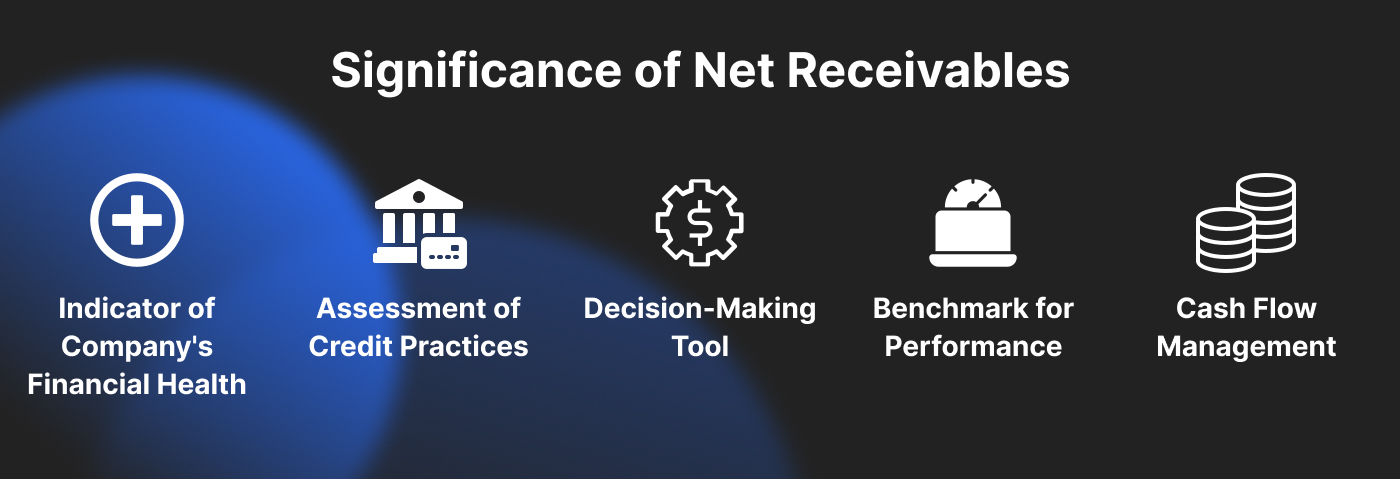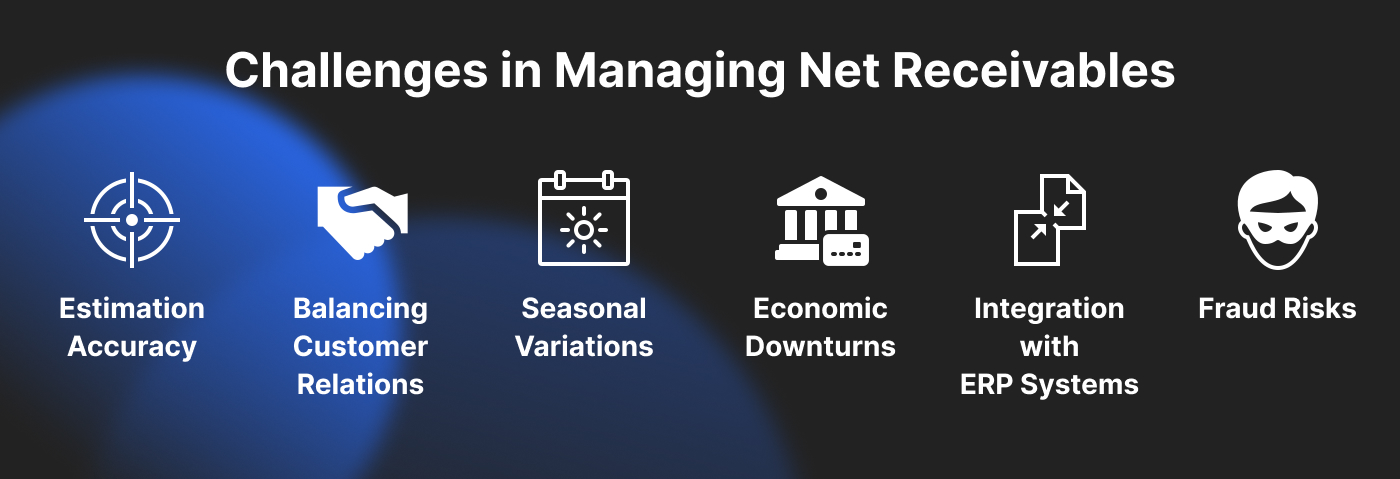What is Net Receivables?
Financial management is vital for businesses aiming to sustain growth and profitability. Among the important KPIs in financial analysis is Net Receivables.
But before we can discuss net receivables, we must first understand account receivables.
Defining Account Receivables
Accounts Receivable (AR) represents the total money owed to a business by its customers for goods delivered to customers or services provided or delivered on credit to customers.
It is recorded as a current asset on the company’s balance sheet and signifies the short-term financial obligations of customers to the business.
Accounts receivable arise from sales transactions where the company extends payment terms to its customers, allowing them to pay after receiving the goods or services.
Managing accounts receivable effectively is critical as it impacts cash flow and liquidity. A high total accounts receivable balance can indicate strong sales; however, it can also point to inefficiencies in collections if customer payments are delayed.
Now that we have understood accounts receivables, let`s see how accounts receivables become net receivables.

Defining Net Receivables
Net Accounts Receivable refers to the amount of money a business expects to collect from its customers after adjusting for allowances such as doubtful debts and sales returns.
Net Receivables play a critical role in shaping a company’s financial strategies, as unrealized receivables could signal inefficiencies in credit or collections processes.

Calculate Net Accounts Receivable
Net Accounts Receivable formula is as follows:
Net Receivables = Gross Accounts Receivable - Allowance for Doubtful Accounts - Sales Returns and Allowances
Components of the Formula:
- Accounts Receivable (AR): This includes the total outstanding invoices due from customers for credit sales.
- Allowance for Doubtful Accounts: An estimation of uncollectible debts based on historical data, customer creditworthiness, and economic conditions.
- Sales Returns and Allowances: Adjustments made for returned goods, pricing disputes, or quality issues that necessitate refunds or discounts.
By applying this formula, businesses can evaluate the net realizable value of their receivables with precision, which is essential for accurate financial planning and analysis.
Consider ABC Inc. with the following data:
- Accounts Receivable: $200,000
- Allowance for Doubtful Accounts: $15,000
- Sales Returns and Allowances: $5,000
Net Receivables = $200,000 - $15,000 - $5,000 = $180,000
Thus, ABC Inc. can realistically expect to collect $180,000, providing clarity on expected cash inflows.
Let’s expand this example with varying scenarios:
Scenario 1: ABC Inc. tightens credit policies, reducing Allowance for Doubtful Accounts to $10,000. Net Receivables increase to $185,000, indicating better risk management.
Scenario 2: A surge in customer disputes raises Sales Returns to $15,000. Net Receivables drop to $170,000, signaling potential operational or product quality issues.

Net Receivables vs. Gross Receivables
Gross Accounts Receivables: Represents the total receivables recorded before any deductions. While useful for understanding total sales on credit, it does not provide an accurate measure of collectible revenue.
Net Receivables: Accounts for anticipated losses and adjustments, providing a more accurate representation of expected collections. This figure is integral to financial reporting and performance analysis, ensuring transparency in financial statements.
Significance of Net Receivables
- Indicator of Company's Financial Health: Net Receivables reflect the realistic cash inflows a company can anticipate, aiding in accurate financial planning. Consistently high Net Receivables demonstrate efficient credit and collections processes.
- Assessment of Credit Practices: A significant variance between gross amount of receivables and net amount of receivables may indicate lax credit policies or inefficiencies in debt collection processes.
- Decision-Making Tool: Reliable Net Receivables data support informed decisions regarding working capital management and operational liquidity.
- Benchmark for Performance: Companies can compare Net Receivables over time or against industry peers to evaluate their credit management efficiency. For instance, analyzing receivables turnover ratios alongside Net Receivables can offer valuable insights into collection efficiency.
- Cash Flow Management: Businesses heavily reliant on credit sales must monitor Net Receivables closely to ensure sufficient cash flow for operations. Delayed collections can disrupt payment cycles, affecting suppliers, employees and cash flow projections.

Strategies to Optimize Net Receivables
- Refine Credit Policies: Develop stringent credit assessment criteria to minimize default risk. This may include:
- Conducting thorough credit checks.
- Requiring partial prepayments for high-risk existing customers.
- Setting clear payment terms and credit limits.
- Extending credit limits for trusted clients to retain them.
- Proactive Receivables Management: Regularly monitor accounts and implement timely collection efforts for overdue accounts. Segmenting accounts receivable by aging can help prioritize collections. For instance, unpaid invoices by more than 90 days may require escalation.
- Incentivize Early Payments: Offer early payment discounts or benefits for customers who settle invoices promptly. For example, a 2% discount for payments made within 10 days can encourage quicker cash inflows.
- Utilize Automation Tools: Employ accounting software to track receivables, manage allowances, and generate detailed financial reports. Tools such as QuickBooks, Xero, or SAP streamline receivables management, reducing manual errors.
- Engage a Receivables Agency: Consider outsourcing collections to a professional receivables agency. These agencies specialize in recovering overdue payments while maintaining positive customer relationships. They offer:
- Expertise in debt recovery.
- Advanced tracking tools.
- Legal support for difficult cases. Partnering with a reputable agency can significantly improve collection efficiency without overburdening internal resources.
- Regular Customer Communication: Maintain open communication with customers to resolve payment disputes or issues promptly, ensuring timely payments. Automated reminders and follow-ups for overdue invoices can enhance efficiency.
- Periodic Policy Reviews: Evaluate and revise credit policies periodically to align with changing market conditions and customer behavior.
By implementing these practices, businesses can enhance their receivables process, reduce bad debt, and improve their overall financial health.
Impact of Net Receivables on Financial Statements
Net Receivables are reported on the balance sheet under current assets. Their accuracy impacts:
- Liquidity Ratios: Metrics such as the current ratio and quick ratio use Net Receivables to assess a company’s ability to meet short-term obligations.
- Revenue Recognition: Overestimating or underestimating Net Receivables can distort revenue recognition and mislead stakeholders
- Investor Confidence: Accurate receivables management enhances transparency and boosts investor confidence, particularly in industries reliant on credit sales.
- Earnings Quality: High-quality earnings are supported by robust receivables management, minimizing discrepancies between reported and realized revenue.

Advanced Metrics Linked to Net Receivables
- Days Sales Outstanding (DSO): This measures the average time it takes to collect payments from receivables. A low figure represents efficient collection practices.
DSO = (Accounts Receivable / Total Credit Sales) × Number of Days
- Bad Debt Ratio: This metric assesses the proportion of accounts receivable written off as bad debt, providing insights into credit risk management.
Bad Debt Ratio = (Bad Debts / Accounts Receivable) × 100
- Turnover Ratio: Indicates how often receivables are converted into cash during a period.
Receivables Turnover Ratio = Net Credit Sales / Average Net Accounts Receivable
- Aging Analysis: Segregates outstanding balances based on how long they have been outstanding, helping identify problematic accounts or trends.
Challenges in Managing Net Receivables
- Estimation Accuracy: Inaccurate allowances for doubtful accounts can lead to misleading financial statements. Businesses must refine estimation techniques using review of historical data and predictive analytics to get a better idea about customer default rates and then monitor the allowance for doubtful debts at regular intervals.
- Balancing Customer Relations: Enforcing strict credit terms while dealing with customers carefully to maintain positive customer relationships. This requires careful management of existing accounts, requiring diversion of time and resources from other critical business operations.
- Seasonal Variations: Industries with cyclical sales patterns may experience fluctuations in Net Receivables, complicating cash flow forecasting.
- Economic Downturns: Economic instability can increase defaults, necessitating more conservative allowances for doubtful accounts.
- Integration with ERP Systems: For large businesses, aligning receivables data with enterprise resource planning (ERP) systems can be complex but necessary for accuracy.
- Fraud Risks: Accounts receivable are susceptible to fraud, requiring robust internal controls to safeguard against manipulation or misappropriation.

Conclusion
Net Receivables are a major part of financial management, offering a realistic view of collectible revenue. Understanding and optimizing this metric equips businesses with the tools needed for improved cash flow management and strategic decision-making.
To ensure accuracy, businesses should establish robust credit policies, regularly review receivables, and leverage technology to streamline processes. A disciplined approach to managing Net Receivables can significantly enhance financial stability and operational efficiency.
Net Receivables not only reflect a company’s operational efficiency but also its commitment to maintaining transparency and financial discipline. By addressing challenges and employing advanced metrics, businesses can optimize their receivables process, ensuring long-term success.
Frequently Asked Questions (FAQs)
- What does low Net Receivables indicate?
Low Net Receivables may suggest ineffective credit policies, high default rates, or substantial sales returns, adversely impacting cash flow.
- How frequently should Net Receivables be reviewed?
Monthly or quarterly reviews are recommended to maintain accuracy in financial reporting and ensure effective receivables management.
- Is it possible for Net Receivables to be negative?
No, Net Receivables cannot be negative.
- Which tools are effective for managing Net Receivables?
Accounting platforms like QuickBooks, Xero, and FreshBooks facilitate efficient receivables tracking and reporting.
- How does Net Receivables impact cash flow?
Higher Net Receivables indicate better cash inflow potential, directly supporting operational liquidity and business growth.
- Can Net Receivables affect tax reporting?
Yes, overestimations or underestimations can impact taxable income and require adjustments during audits, making accuracy critical.










